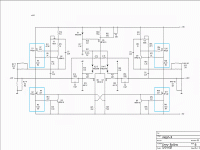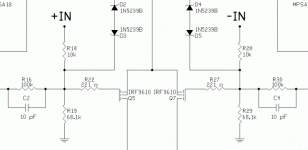grataku said:golden values
For example, many people have told me that 68K in the input gives way too forward treble.
It is now a month of living together with aleph x / 68k input.
I will try 10k input and listen to .
🙂
stefanobilliani said:
What voltage rails , and current sets ?
sorry,
 mmmmh , the answer is already write
mmmmh , the answer is already write 
stefanobilliani said:
It is now a month of living together with aleph x / 68k input.
I will try 10k input and listen to .
🙂
Cool! When I swap the mills resistors in I will try 68k.
Maybe you should do it first and tell me if it's worth to move up. 😉
I'm curious to see what a compatriot thinks about it.
Probably due to heatsinks, there was a general tendency of wimping out on the transformer ratings, people went for crazy low voltages like 11-0-11. I now have 14-0-14 at the rails that's about all my heatsinks can handle and that's already a 70 lb beast.
I think I have been much better off listening to an AX prototype with low rails than with what I was listening before.
The monoblocks I plan to build will be able to dissipate a total of 800W and I will go out to 25-0-25 with 8 amps/chn.
Hello,
I had to change the R12 and R34 alot to get to about 54% of current gain. With the 1K2 I got;
OUT NEG
0.063V 0.082V
0.572A 0.372A
34.9%
When I changed to parallel (1k2+4k68+4k68)=793 ohm I get about;
OUT NEG
0.051V 0.044V
0.460A 0.2A
56.8%
Yeah... So the default 1K2 does not work very good over here!
Edwin
I had to change the R12 and R34 alot to get to about 54% of current gain. With the 1K2 I got;
OUT NEG
0.063V 0.082V
0.572A 0.372A
34.9%
When I changed to parallel (1k2+4k68+4k68)=793 ohm I get about;
OUT NEG
0.051V 0.044V
0.460A 0.2A
56.8%
Yeah... So the default 1K2 does not work very good over here!
Edwin
Nelson Pass

Is this opinion based on the 240 FET? Would this situation change if the 044 or 150 FET were used instead? Higher voltages make using higher biases more problematic because of the heat dissipation issues so which amp will sound better: The Aleph-X with 16V rails and 20A of bias or the one with 20V rails and 12A of bias? Doesn't this decision have alot to do with the impedence load expected to be driven by these amps? I don't know if you missed my last post here but I am in the process of building an Aleph-X and would find a reply here very helpfulMyself, I would go with 24 or 25 volts.

Could someone tell me the gain and sensitivity of the AlephX?
Would it be possible to adjust either of these figures?
Is sensitivity reduced simply by shunting the input to ground?
Would it be possible to adjust either of these figures?
Is sensitivity reduced simply by shunting the input to ground?
The gain is the ratio of the feedback resistors divided by the input resistors. Adjust as you like.
I have no gain and my sensitivity is up.
This is what I did .... reprinted and reread the Aleph-30 stuff.
It sure helps, happy green beer, thxs nelson
This is what I did .... reprinted and reread the Aleph-30 stuff.
It sure helps, happy green beer, thxs nelson
Rf/Ri
That helps, Now I just have to figure out the schematic well enough to recognize which are input and feedback resistors in the various stages.
zero gain, that means your just controlling current with the thing?
Thanks
That helps, Now I just have to figure out the schematic well enough to recognize which are input and feedback resistors in the various stages.
zero gain, that means your just controlling current with the thing?
Thanks
0 gain means 0 output
0dB gain means gain=1; and here, the output voltage is equal to the input voltage
in this case, yes, you just control the current woth the aleph x
Gain(dB)=20*log10(Vout/Vin)
here, Vout/Vin=Rfeedback/Rin
so
Gain(dB)=20*log10(Rfeedback/Rin)
edit: just add "-" if you want, since the AX is an inverting amp
0dB gain means gain=1; and here, the output voltage is equal to the input voltage
in this case, yes, you just control the current woth the aleph x
Gain(dB)=20*log10(Vout/Vin)
here, Vout/Vin=Rfeedback/Rin
so
Gain(dB)=20*log10(Rfeedback/Rin)
edit: just add "-" if you want, since the AX is an inverting amp
Fritz said:Now I just have to figure out the schematic well enough to recognize which are input and feedback resistors in the various stages. zero gain, that means your just controlling current with the thing?
Zero gain means no output at all.
If someone will post a schematic to which I can reference, I will be happy to point out the resistors in question.
By the way, how do you guys manage to put up big graphics? All I ever manage is itty bitty ones that often show up only as a link.
😕
MOSFET Socket
Mr. Pass,
Are there mosfet socket? I have looked for some. But, all I found are sockets for small transistors.
Thanks
Mr. Pass,
Are there mosfet socket? I have looked for some. But, all I found are sockets for small transistors.
Thanks
Will this fly
One of the members once mentioned a patent 5,470,795 that could fit the bill.
http://patft.uspto.gov/netacgi/nph-...,470,795.WKU.&OS=PN/5,470,795&RS=PN/5,470,795
http://patimg2.uspto.gov/.DImg?Docid=US005470795&PageNum=1&IDKey=F528271A912A&ImgFormat=tif
http://patimg2.uspto.gov/.DImg?Docid=US005470795&PageNum=2&IDKey=F528271A912A&ImgFormat=tif
http://patimg2.uspto.gov/.DImg?Docid=US005470795&PageNum=3&IDKey=F528271A912A&ImgFormat=tif
http://patimg2.uspto.gov/.DImg?Docid=US005470795&PageNum=4&IDKey=F528271A912A&ImgFormat=tif
http://patimg2.uspto.gov/.DImg?Docid=US005470795&PageNum=5&IDKey=F528271A912A&ImgFormat=tif
I will use the following method to finish my Aleph-X
http://patimg1.uspto.gov/.DImg?Docid=US006527217&PageNum=1&IDKey=9E1B12621D13&ImgFormat=tif
http://patimg1.uspto.gov/.DImg?Docid=US006527217&PageNum=2&IDKey=9E1B12621D13&ImgFormat=tif
http://patimg1.uspto.gov/.DImg?Docid=US006527217&PageNum=3&IDKey=9E1B12621D13&ImgFormat=tif
One of the members once mentioned a patent 5,470,795 that could fit the bill.
http://patft.uspto.gov/netacgi/nph-...,470,795.WKU.&OS=PN/5,470,795&RS=PN/5,470,795
http://patimg2.uspto.gov/.DImg?Docid=US005470795&PageNum=1&IDKey=F528271A912A&ImgFormat=tif
http://patimg2.uspto.gov/.DImg?Docid=US005470795&PageNum=2&IDKey=F528271A912A&ImgFormat=tif
http://patimg2.uspto.gov/.DImg?Docid=US005470795&PageNum=3&IDKey=F528271A912A&ImgFormat=tif
http://patimg2.uspto.gov/.DImg?Docid=US005470795&PageNum=4&IDKey=F528271A912A&ImgFormat=tif
http://patimg2.uspto.gov/.DImg?Docid=US005470795&PageNum=5&IDKey=F528271A912A&ImgFormat=tif
I will use the following method to finish my Aleph-X
http://patimg1.uspto.gov/.DImg?Docid=US006527217&PageNum=1&IDKey=9E1B12621D13&ImgFormat=tif
http://patimg1.uspto.gov/.DImg?Docid=US006527217&PageNum=2&IDKey=9E1B12621D13&ImgFormat=tif
http://patimg1.uspto.gov/.DImg?Docid=US006527217&PageNum=3&IDKey=9E1B12621D13&ImgFormat=tif
Thanks, I rigged up something like the first one with screws. But, I found it time consuming testing mosfets by screwing them in and out. I was trying to find a socket like a vacum tube type sockets.
Nelson Pass said:[B
If someone will post a schematic to which I can reference, I will be happy to point out the resistors in question.
[/B]
A small size of the schematic by Grey Rollins at post#1 revisited
Attachments
Nelson Pass said:By the way, how do you guys manage to put up big graphics? All I ever manage is itty bitty ones that often show up only as a link.
If the graphic is already out in webspace you can use the image tag and the pictures URL (i'm not sure if there is a size restriction but i would guess there is). Sometimes -- for a still unfathomed reason -- linked gifs will show up only as a link, in which case you have to resort to real html to get the picture to show,
If you attach a picture to the forum it is limited to 800 pixels wide And must be below a certain size (and a gif or a jpeg -- gif is best for schematics)
dave
Thanks for posting this Steffano.
I would be trying to adjust this to 27dB gain. I see R18 and then its mostly Greek to me.
When one starts changing gain does evrything else like stability change?
Id like to run two channels of AX at 20-50 watts for high and mid and then P3A or even the TDA 7293 for the base at 90watts or so.
I think this would be a reasonable amount of heat especially if I park the Alephs in the fireplace during the summer.
I would be trying to adjust this to 27dB gain. I see R18 and then its mostly Greek to me.
When one starts changing gain does evrything else like stability change?
Id like to run two channels of AX at 20-50 watts for high and mid and then P3A or even the TDA 7293 for the base at 90watts or so.
I think this would be a reasonable amount of heat especially if I park the Alephs in the fireplace during the summer.
- Home
- Amplifiers
- Pass Labs
- The Aleph-X

